Donald Campbell Atkinson was a brilliant and expert horseman who learnt his craft on Surrey Hills during the twentieth century while grazing 2,000 head of cattle. Fortunately, his son, Lindsay, wrote a couple of unpublished memoirs which beautifully capture some of Donald’s accomplishments and amazing adventures. The first, written in 1994, was titled “A few notes about my father’s family”. The other focused on the unsung and all-but-forgotten exploits of his father. It was submitted to “The Greatest Stories Never Told” project established by the Australian Bicentennial Authority in 1988. While Lindsay’s short story was not selected for the subsequent book, “Unsung heroes and heroines of Australia”, I now have an opportunity to share Donald’s remarkable story and achievements through Lindsay’s words.
Undoubtedly, Donald Atkinson was a very skilful stock rider. With his superior horse-riding skills, he deserves appropriate recognition as one of Tasmania’s best-ever stockmen.
The quotes below about Donald are directly from Lindsay’s memoirs, which were kindly provided by Donald’s daughter Kathleen. Thanks also to Kathleen’s daughter, Diana van Bell, who assisted in compiling the photos and documents and sending them onto me.
In my book “Fires, Farms and Forests”, I detailed the association William Henry (W. H.) Atkinson and his family had on Surrey Hills during the twentieth century. A short biography on W. H. Atkinson (1844-1918) in the book provides a summary of his life:
“The Atkinson family was associated with all facets of the meat industry from cattle farms to droving and butcher shops (‘knights of the cleaver’). W. H. Atkinson was Irish born and emigrated to Tasmania when he was ten year’s old. He initially worked on his father’s property before turning to bush farming in 1865. He made considerable sums from packing to and from Mount Bischoff and other mining centres. His prize Durham bull, from the VDL Co. produced some fine offspring, perhaps not much more than Atkinson himself who had 16 children by his two wives. He was a large-scale land speculator in the north-west, in fact, by 1900 he was regarded as the biggest landowner in Burnie. He had leaseholds and stock runs from Burnie to Guildford Junction, and land on King Island. The latter was used for fattening store cattle before being shipped to the west coast and Launceston. His involvement in the west coast industry was substantial with claims that by 1900 ‘he does nearly half the meat supply trade [sheep and cattle] of the West Coast’. He was a classic example of integrating all levels of the meat industry from production and distribution to retailing, owning several butcheries in Zeehan and Queenstown”.
W. H. Atkinson first became involved on Surrey Hills in March 1903 when he and three of his sons, Thomas, William Henry Junior and Donald Campbell, leased between 3,000 and 4,000 of land between Burghley and Thompsons Park at one shilling per acre for the first seven years, with an option to renew the lease for another seven years at two shillings per acre. They also agreed to rent 100 to 150 acres near Guildford Junction at four shillings per acre per annum. They wanted to use this small area for accommodation paddocks and experimental cropping. Atkinson was also the first to take out a lease at Hampshire Hills over 100 acres as a resting paddock while droving cattle from Burnie to his Surrey Hills run.
All of W. H. Atkinson’s sons were powerfully built. Atkinson was exceptionally strong himself, able to lift a bag of oats in his teeth. Lying on his back under a great bullock dray and placing his feet under the axle, he could push it off the ground.
Donald Atkinson thrived on the work looking after cattle on Surrey Hills. It was here he developed his horse riding skills and was essentially responsible for running the Atkinson cattle herd as part of his father’s cattle empire across north-western Tasmania. Born in 1883, Donald quickly gained a reputation at a young age.
“Dad was never thrown off a bucking horse or even a bucking steer…A certain man had a wild steer he kept in yard for a bit of sport. He was offering a whole shilling to anyone who could ride it for 10 seconds. Dad took up the challenge and won the shilling. It was the only shilling the owner had to part with as no one else ever stayed on the steer”.
The VDL Co. Chief Agent, Andrew Kidd McGaw, relied on him to show prospective purchasers and lessees around Surrey Hills on horseback. McGaw wrote to the Court of Directors in London:
“…if Donald Atkinson was not there I should have to make arrangements for someone else. A stranger could not find his way around Surrey Hills”.
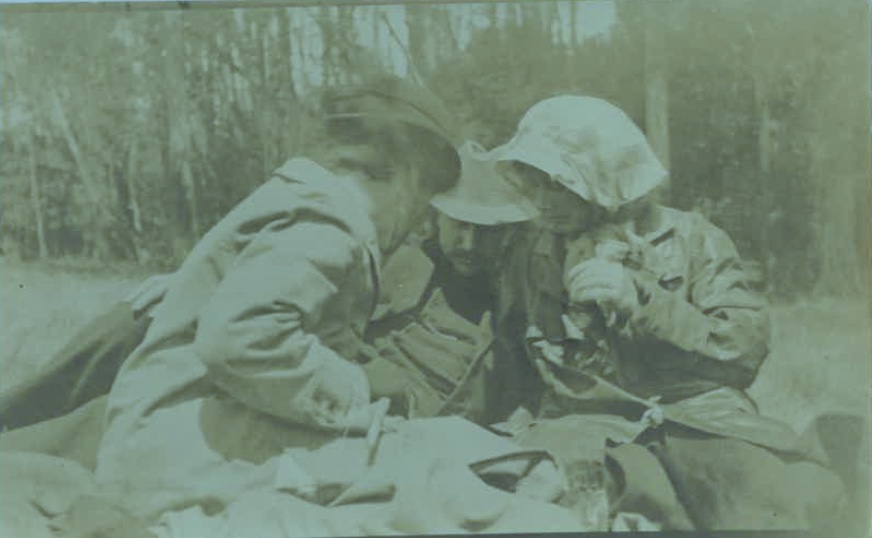
Indeed, Donald was a very fine stockman and very good on a horse. He was:
“…extremely athletic and gifted in the handling of stock, being particularly talented in the art of horse riding…He was provided with a marvellous horse, a cross between a thoroughbred mare and an English high-stepping Hackney stallion. The horse was coal black, and as a jumper and stockhorse had no peer in Tasmania. His speed was phenomenal. He could gallop through thick bush, floating over logs, rocks and dead limbs as if following a perfectly clear track. His name was Nigger.
I was told by several old timers that Dad took Nigger over to the Melbourne Show and won the Camp drafting and bulldogging events there. Bulldogging the American way is to chase the beast at full gallop, slide off your horse onto the beast’s neck, grasp the horns, dig your feet into the ground and twist the beast’s head towards you until it comes over onto its side. Dad had his beast on the ground in half the time it took the cowboys struggling with the horns. The officials made him give repeated demonstrations for the benefit of the crowd. They had never seen anything like it. I don’t know why Dad never mentioned his trip to the Melbourne Show to me, too modest I suppose.”
In 1904, W. H. Atkinson was keen to buy land at Burghley, the pick of the land on Surrey Hills, on behalf of Donald as he was spending a lot of time on Surrey Hills. He also subsequently bought blocks at Thompsons Park, Chilton and Clipper East.
“…at the age of 20, Don, 6 ft 1 in, with a superb physique, was chosen by his father to be head stockman at Surrey Hills.
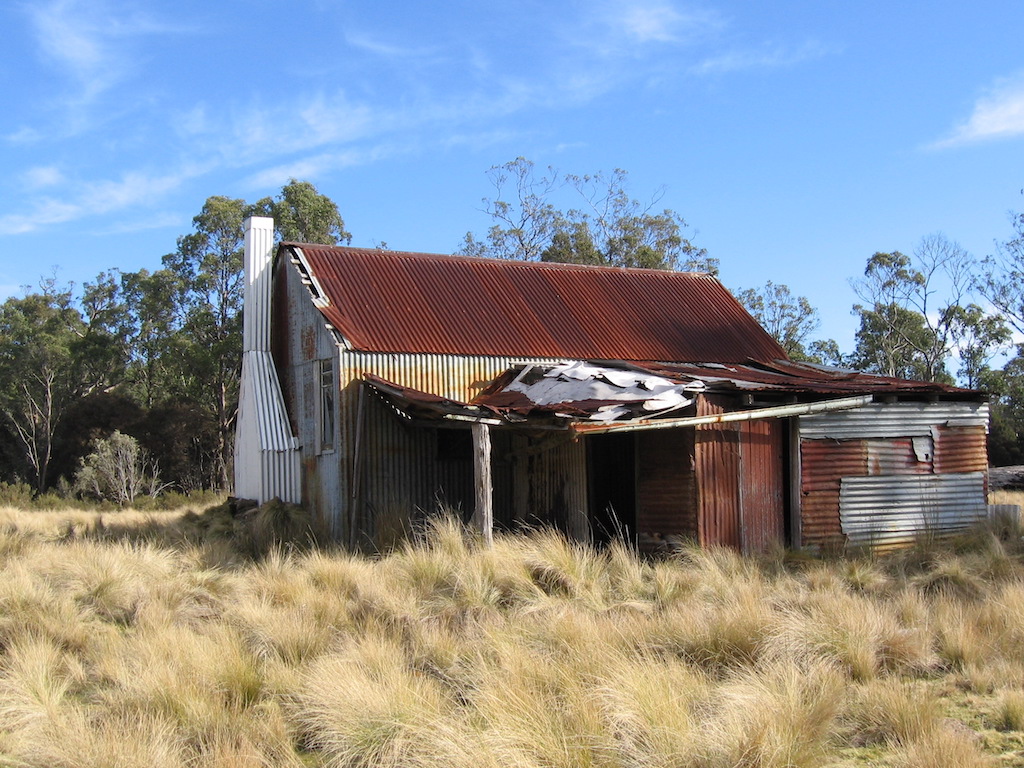
During that year, they built a hut at Thompsons Park to provide shelter when they were active mustering on their runs.1 The Atkinsons quickly found out about an occupational hazard that needed to be addressed – wild mobs of cattle roaming Surrey Hills. Donald and his horse Nigger became famous for their exploits rounding up wild cattle at Surrey Hills, descended from Field brothers’ cattle that had strayed years earlier. He shot over 200 wild bulls with an old Lee Enfield .303 rifle that was used in the Boer War. Donald could shoot a bull at full gallop on Nigger, because Nigger ran so smoothly. He fired behind the shoulder, straight through the heart and never missed.
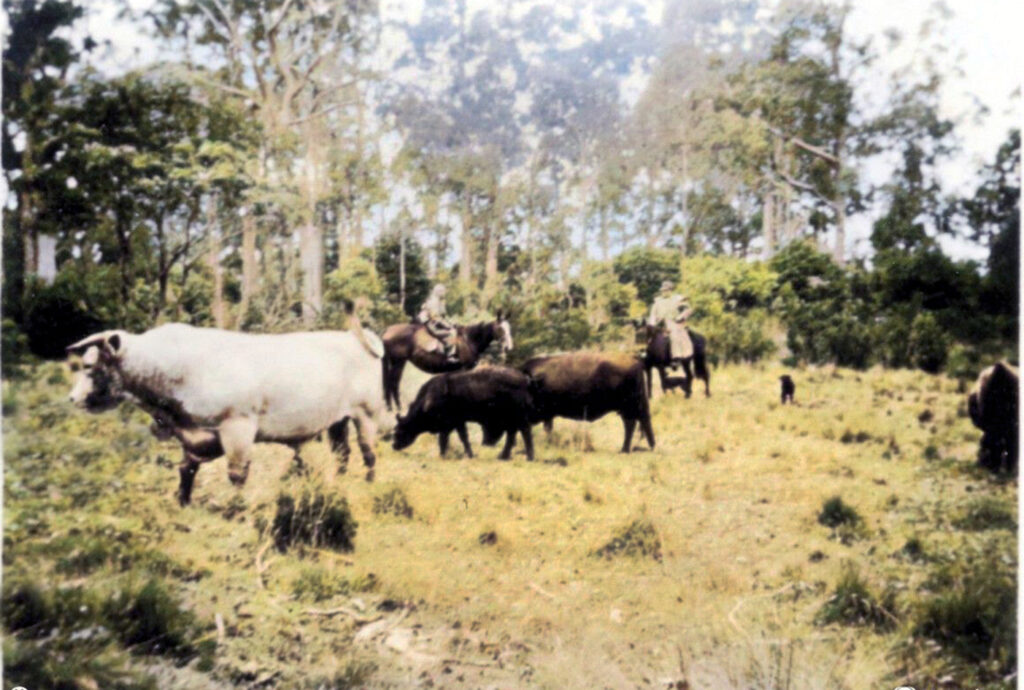
Here is an extraordinary story of Don’s bravery and skills dealing with these wild mobs:
“These cattle were large, lithe and ferocious, and could run as fast as most horses. They were so wild that one had been known to charge a train, breaking its neck and dropping dead in consequence. If they could not gore, they would bite and kick! These cattle had to be exterminated or captured and tamed, as they led the quiet ones away to become feral like themselves.
The method Don used to capture a wild bull was to run it down on horseback, grab its tail, accelerate the horse and pull the bull off balance onto its side, reign in, spring from the saddle onto the bull, and strap its legs before it could rise. Sometimes the bull regained its feet before this could be accomplished.
On such occasion, Don found himself facing an irate and fuming bull with nothing in between them but empty air. The bull promptly charged. Don sidestepped and grabbed the bull’s tail, sliding his feet under its belly. As the bull spun, trying to gore Don, its hindquarters moved Don just out of its reach. Don was spun round in a circle for more than an hour before other stockmen appeared and set dogs onto the bull, Don walked slowly backwards until he reached a tree and safety.
On another occasion Don found himself in the same situation in a clearing, on foot, facing another incensed bull. However, this time there were a few pepper bushes about. He whipped off his Bluey overcoat, draped it over a bush, and dived flat on the ground. The bull charged the Bluey, and galloped blindfolded over a bank into a deep river.
Another time, although a stake had pierced Don’s eye, he still kept on and captured the bull.
Visiting professional American cowboys of the Rodeo circuit tried to capture these bulls with their methods, but only succeeded in getting their horses gored.”
There was a number of high quality horses at Surrey Hills used in addition to Nigger.
“…there was a magnificent black thoroughbred mare bred by the Field brothers. She had a white star on her forehead and was called Moonlight. Coming home one evening after a hard days work Moonlight was still in high spirits and prancing quite a bit. Luke Etchell, who was aboard and tired out, was wishing she would simmer down. There was an old log across the track with a few pepper bushes growing against it. The other horses stepped or hopped over the log, but Moonlight decided to jump the pepper bushes as well. Unprepared for such high jinks at that time of day, Luke was catapulted into the air as far as the reins would let him go.
Another great jumper was a grey bred from a Field’s thoroughbred mare by a pure Arab sire called Mirage. This grey Anglo-Arab just from high spirits jumped a piece of bark that was hanging between two trees. All the other riders just ducked their heads and went under it. This time the rider, Jim Shaw, was not dislodged.”
Every winter several hundred steers were brought down to Burnie from the Surrey Hills runs, and shipped to King Island to be fattened.
“They were driven straight through the streets of Burnie to the wharf. Several times Dad had to bowl over a beast that was chasing some pedestrian. Some of the steers jumped off the wharf into the sea and swam for miles along the coast before coming ashore”.
Donald had dogs to help muster the cattle on Surrey Hills. The most outstanding were Rap, Trap and Dot, black and tan smooth-coated English collies.
“Each one of these dogs would muster a 1,000 acre run by itself, finding the cattle by scent. They would find a few cattle and drive them to a central clearing, then go away and find a few more and bring them to the same clearing, gradually bringing all the cattle on the section together. They knew all the fording places and took the cattle to them all on their own initiative. Dad would know by their barks when the cattle were gathered.
In between avoiding being gored by wild bulls and herding steers to Burnie, Donald found time to marry Ida Amelia Remfry Grove in 1909. Ida also participated in the musters on horseback. At one time, she was chased by a bull at Surrey Hills.
“Fortunately she was on Nigger (she always bagged him). The bull came at Nigger who always believed that discretion was the better part of valour. He turned and bolted for the tall timber and scrub. He soon outdistanced the bull, but Mum who managed to stay with him had every pin scraped out of her hair. If it hadn’t been so long, it would have been standing on end”.
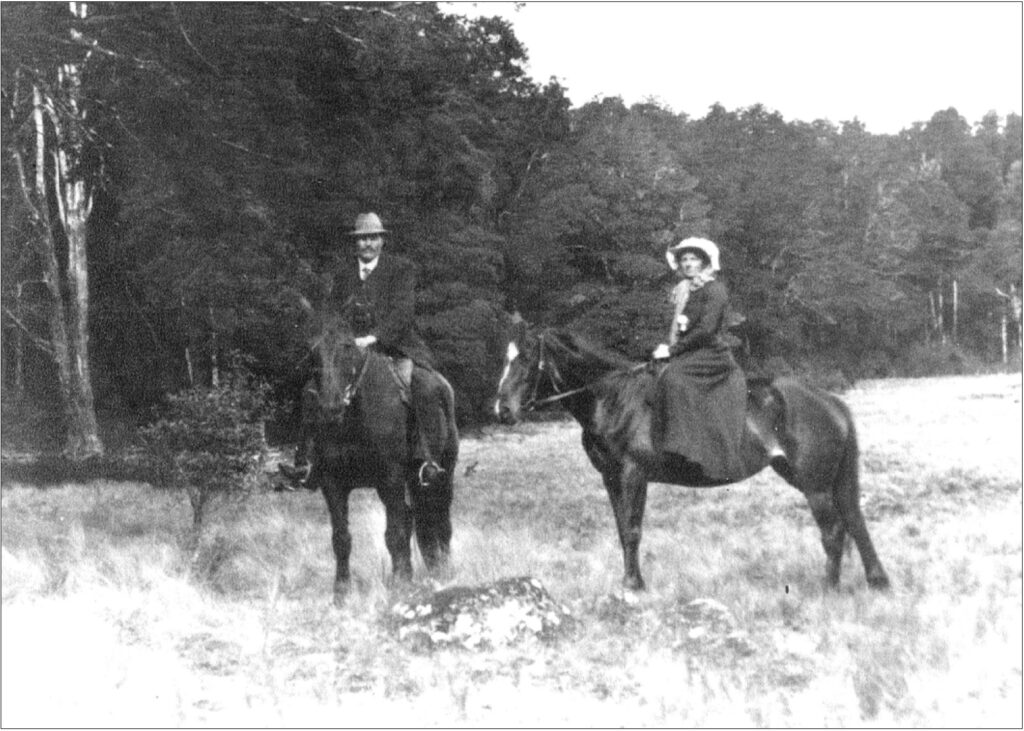
W. H. Atkinson died in 1918 and the blocks on Surrey Hills were inherited by Donald. Around this time, Donald had a young family with Marie born in 1917, Lindsay in 1920 and Kathleen in 1925. With the demands of raising a young family with his wife, Donald sold his blocks on Surrey Hills in 1924. Their home was ‘Hillburn’ located in Upper Burnie.
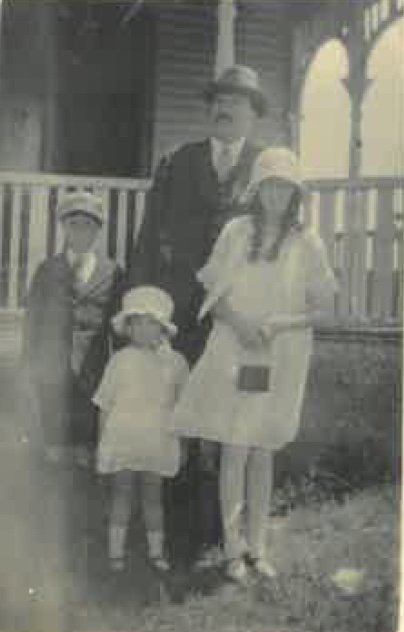
Lyndsay recalled riding Nigger when he was three years old. Nigger was about 25 years old then, but still active and fit. Donald’s next stock horse was Tommy:
“When Tommy came along and was weaned (his mother was the chestnut pony Peggy and his father was the famous thoroughbred racehorse Tasman’s Isle), Dad took him and Nigger back to Tewkesbury and turned them out on the 1,200 acre cattle runs there that Dad later sold to Fred Hays. There was good grass and clover with logs everywhere. The idea was for Tommy to become sure footed and used to negotiating logs at an early age, coached by the old master Nigger. His plan was very successful as Tommy later became a great stock horse.
Dad had a battle royal with him when he was being broken in. On a cattle trip Dad had only reached Romaine [from Burnie] when Tommy mutinied and started to buck. He bucked for a solid hour on the side of the road trying to dislodge Dad. He eventually stepped into the table drain and fell flat. When he got up and found Dad still on his back, he resigned and never bucked again”.
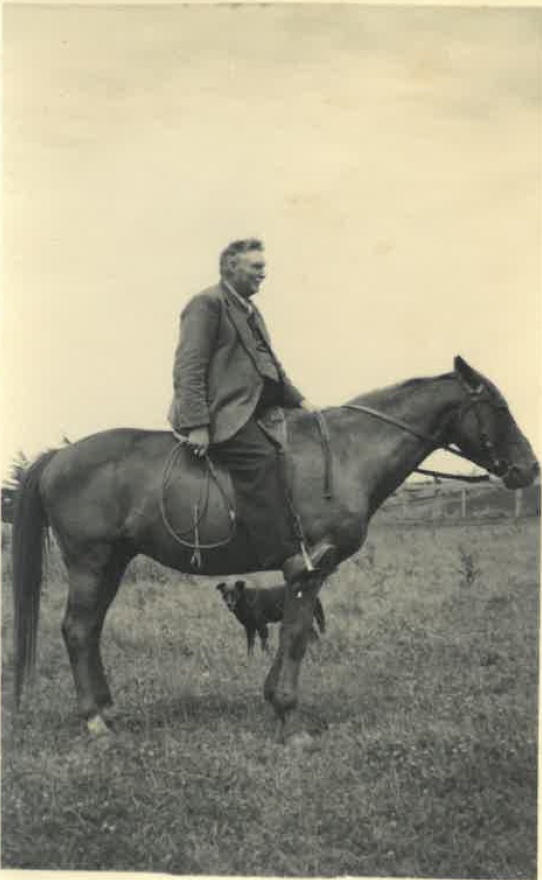
Donald repurchased the original family blocks at Chilton and Clipper East in 1940, and Burghley and Thompsons Park in 1944, all from the Field’s family company, Western Highlands Pty Ltd. It is believed the Chilton and Clipper East blocks were bought to allow Lindsay to continue the family cattle grazing traditions on Surrey Hills. Lindsay bought the latter two blocks off his father soon after, in 1946.
After taking possession of Burghley and Thompsons Park, Donald quickly sold them to close family friend and fellow Surrey Hills stalwart, Luke Etchell, himself a very accomplished bushman who lived at Guildford Junction for nearly half a century.
Donald was a keen gardener and he walked seven miles in the rain at the Hellyer Gorge to find a rare specimen of white-flowering waratah. After planting it in his garden at ‘Hillburn’, the plant produced blooms of white flowers. He was also a devoted member of the Burnie Gospel Hall Assembly for over 50 years.
Donald died suddenly in January 1952. His obituary was published in the Burnie Advocate and gave a special tribute to his bush skills:
“…a well-known and highly respected resident of Upper Burnie…He is remembered by many old identities in the back country for the part he played in the Surrey Hills area. In some parts of the wild bush and plains, which for him held a special appeal, he was the only man who could completely negotiate the country. An expert horseman, he handled many hundreds of cattle, and despite disability, until a brief period before his death he indomitably continued his own cattle mustering”.
Donald Atkinson was a brilliant stockman and bushman. We are fortunate that his exploits were recorded by his son so that we can acknowledge his skills and his ability to tame the wild mobs of cattle that roamed Surrey Hills in the early part of the twentieth century – a legacy of the Field brother’s occupation of Surrey Hills the previous century.
1 The hut still exists at Thompson Park. The interior is lined with Baltic pine.

A terrific story Robert. We can only imagine the fortitude and resilience of the early pioneers and their families on Surrey Hills. The place reeks of astonishing history ! Cheers, Bryan.
William Henry Atkinson was my great great grandfather. My line is from his daughter Annie who married Kittles Tronerud, who was sent to King Island to manage the land. Cattle were sent there to be fattened.
I live in Queesnland and also worked cattle properties in the 70s, later having my own herd for a while. I was also a good horseman never been thrown, could crack a whip, using it to pick oranges. I was charged by wild bulls, dragged by a wild heifer etc, so Donald’s blood is in me.
I’m 6ft 4in 140kg, used to be strong as an ox, but sadly age has caught up with me.
What Great family history I have, enjoyed reading your story on Donald Atkinson.
Cheers Bevan from Sapphire Central Qld 🤠🦘🦘🇦🇺
Great hearing from you Bevan and thanks for sharing some of the Atkinson family history.
You certainly seem to have some of Donald’s skills as a horseman.
Thank you Robert, Diana and Kathleen for telling Don’s story, one which deserves to be recorded and enjoyed by our relatives and friends. So interesting to read about the exploits of the Atkinsons at Surrey Hills and beyond.
Good story, Robert
A brilliant story, Robert. It is a part of my family history about which I know only fragments. I am William Henry Senior’s great-granddaughter, granddaughter of William Henry Jnr, daughter of Eric Atkinson.
Great to hear from you Christine and glad you enjoyed the story about your granduncle.
Please pass it on to your family members that may be interested. I know there are a lot of descendants of the patriarch, William Henry senior.
I remember when I was young, mid 60s, of a man who rode his horse over the land west and south of what is now Thorn Street. We used to call him Whiplash. Would this be Lindsay?
Yes it would have been Lindsay, as he owned the land between Mount Road & Mooreville Rd .
Michael, Lindsay’s sister says she never heard of the nickname ‘whiplash’, she can’t be completely sure as she left Burnie during that time. However she thinks the rider would most likely have been Lindsay, as Bev and Lindsay were living there at the Hillburn property. Lindsay had a purebred white Arab horse at the time (his favourite), and a chestnut and a dark brown horse.
Atkinson’s Hillburn property is now a large residential sub-division, which still retains the historical “Hillburn” name.
Hello Robert.
A beautiful story. I too am an ancestor of William Henry Snr, however I cannot piece together my family tree. My maternal Grandfather was born 2nd August 1919 and was adopted. His birth mother was a young lass from Upper Burnie, Gladys McGrail. I took a DNA test and my closet match is Donald’s daughter Kathleen, a 3rd cousin so I’m guessing William Snr is my GG or 3 x Great Grandfather.
There’s quite a few matches that trace back to William Snr. As you know, people love finding new lost family members but it can be a touchy subject. However, Gladys had a daughter who is still alive when I discovered pop’s birth mother. We were so alike and the family had racehorses and working dogs, like me and mum and pop was an auctioneer and bought beef cattle for Roberts for King Island and everyone actually, not to mention all the other menagerie of furry & feathered friends.
Unfortunately, Aunt Mary passed away very suddenly in 2021. I was devastated, but I’m still close with her daughters and grandsons. Gladys had 4 other babies after Pop between him in 1919, Mary 1921, Isabel 1923 who died an infant, Rex Paul 1926 & in 1929 Gloria who was the last. She died an infant in Wynyard. She was christened at St Brigid’s Catholic Church in lieu of illness (I delivered the school supplies there). After she married she had Mary 1936 & Gary 1937 (died 1976).
Anyway I will check my DNA matches to see if the other lovely people have taken a test. Thank you again.
Teena Moore Miena,Tasmania
Hi Teen. I am not surprised there are many descendants of WH Atkinson – he fathered quite a progeny in his time! Good luck with your family history search.